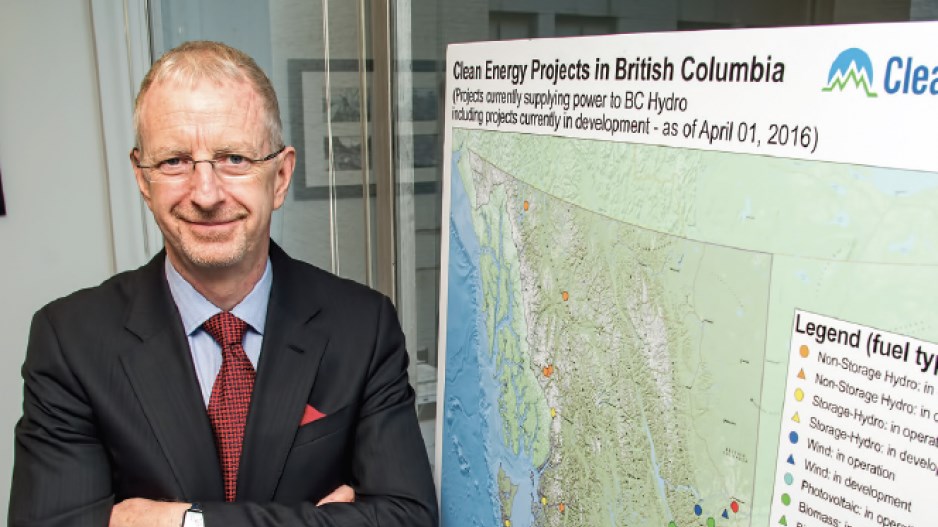The BC Utilities Commission (BCUC) has rejected BC Hydro’s agreement to renew electricity purchase agreements with three independent power producers for 40 years, saying it may not be a good deal for ratepayers.
The BCUC cites uncertainty over B.C.’s long-term energy needs, based on the absence of a new integrated resource plan (IRP) – not expected until 2021 – and B.C.’s recently acquired status as a net importer of electricity.
The BCUC is not prepared to approve 40-year terms for renewing electricity purchase agreements (EPAs) with independent producers, at least not until BC Hydro has completed its next IRP in 2021 and demonstrated a need for the power.
Meanwhile, the clock is ticking on electrification of the natural gas and liquefied natural gas (LNG) industries. Decisions need to be made soon on B.C.’s power needs, if electrification of these sectors is to keep pace with LNG infrastructure development.
B.C. could lose some clean-power generation if long-term contracts with independent power producers aren’t renewed, Clean Energy BC warns.
Three small hydroelectric projects built in the 1990s provide a total of 170 gigawatt hours (GWh) of power (Site C dam would generate 5,100 GWh): Sechelt Creek, Brown Lake and Walden North.
“In the absence of an EPA, the Sechelt Creek IPP [independent power producer] has stated that it is uncertain whether or not the Sechelt Creek project may be decommissioned or decommissioned early,” the BCUC noted in its recent decision.
“If they don’t renew the EPAs, there’s no commercially viable way to keep them open,” said Martin Mullany, interim executive director of Clean Energy BC. “So, yes, if they don’t renew the EPAs, you could lose the projects.”
The BCUC has given BC Hydro and the three power producers 60 days to come back with purchase agreement renewal proposals of no more than three years.
Until BC Hydro publishes its next IRP in 2021, the BCUC is not convinced the 40-year renewals that BC Hydro agreed to are a good deal for ratepayers.
If the energy they produce is surplus to B.C.’s needs, BC Hydro might have to sell the power at rates lower than what the utility pays for it.
“The panel finds insufficient evidence that any of the three EPAs are cost-effective over the 40-year contract period,” the BCUC said.
The BCUC decision opens a wider debate, however – one that has been brewing ever since the provincial government passed its CleanBC climate change and energy plan and final investment decisions were taken on two LNG projects. The debate centres around the question of whether BC Hydro is underestimating how much power the province will need in the coming years – or is doing its job and protecting ratepayers from an overbuild of wind and run-of-river projects that aren’t needed.
Could the delays in getting an IRP done hamper attempts to electrify B.C. natural gas and LNG industries?
David Austin, a lawyer specializing in the electricity market with Stirling LLP, said the answer is a categorical “yes.”
He said BC Hydro is projecting increased annual electricity demand of only 1% over the next two decades – something that appears not to take into account the nascent LNG industry and greater electrification of the economy that is a cornerstone of the CleanBC plan.
“It’s not possible to meet the objectives of the CleanBC plan, and increased fossil fuel production, with a load forecast of 1% over the next 20 years,” Austin said.
When the $10.7 billion Site C dam was approved, it was assumed that B.C. would have a significant power surplus for some years, because the province already generates at least as much power as it needs, and sometimes more.
BC Hydro conducts an exhaustive integrated resource plan every five years and then publishes load forecasts periodically. The last IRP was produced in 2013.
Since then, the CleanBC plan was passed, two LNG projects – LNG Canada and Woodfibre LNG – were sanctioned, as was Site C, and the B.C. government approved a second transmission project intended to electrify more of the natural gas sector in northeastern B.C.
“None of that is fully reflected in the most recent June 2019 load forecast,” Austin said.
The Pacific Institute for Climate Solutions recently estimated that B.C. will need to double its electrical generating and transmission capacity to fully electrify the transportation sector in B.C. However, that is expected to take place over 35 years.
The electrification of the LNG and natural gas industries would need to occur much sooner to ensure that an electricity supply is available before new plants and other infrastructure are built. Companies are unlikely to electrify their facilities without assurances that that power supply will be available. They would have to use natural gas to power most of their newer facilities.
Despite assertions it has a power surplus, B.C. was a net importer of electricity in 2018, said Clean Energy BC, something BC Hydro attributes to a colder-than-normal winter.
“BC Hydro has two messages,” Mullany said. “One is ‘We have way too much supply, we’re in excess,’ and on the other hand, ‘We need to do a deal with Powerex because we need to import power because we have a shortfall.’ What BCUC is saying is ‘Get your story straight and come back to us.’”
A request for an interview with the provincial energy minister was referred to BC Hydro, which responded in an email, saying it is renegotiating power purchase agreements with independent producers, but at lower rates than what they originally received, as per directions of a government review of BC Hydro operations.
“As a result, we’ve been renewing contracts with IPPs at prices less than what they would have been paid under the original contracts, recognizing that these have typically recovered most of their capital costs over their original contract terms. In addition, in most cases, the price being paid for electricity from IPPs is higher than current market rates.” •




